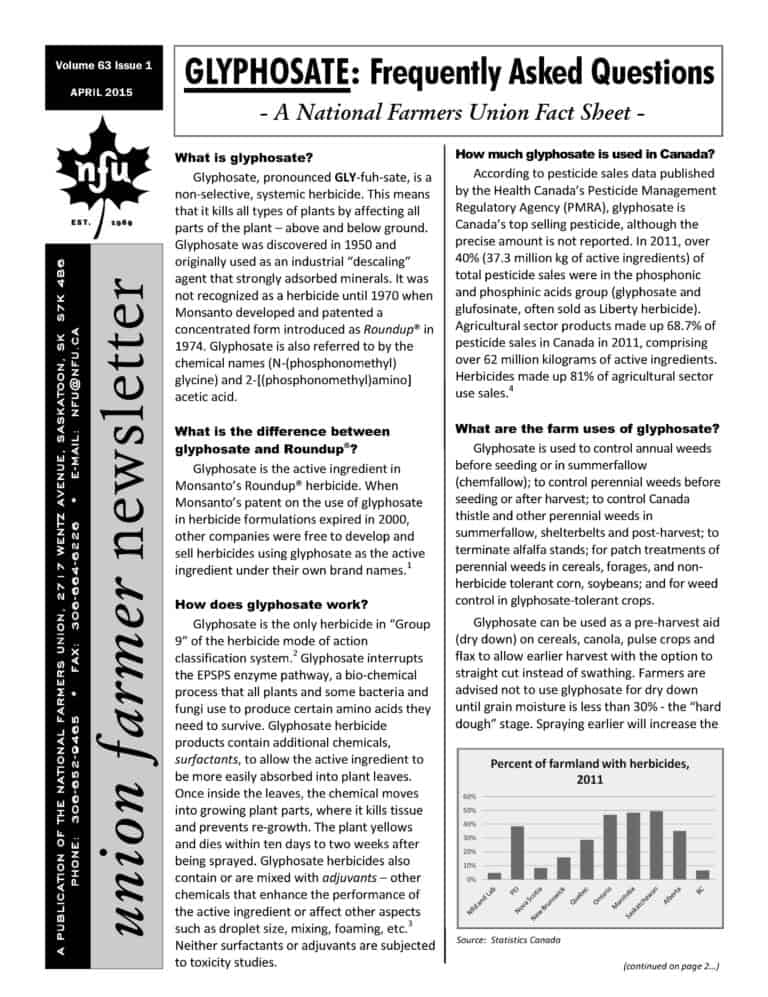(Please download the PDF version to view all the graphs)
What is glyphosate?
Glyphosate, pronounced GLY‐fuh‐sate, is a non‐selective, systemic herbicide. This means that it kills all types of plants by affecting all parts of the plant – above and below ground. Glyphosate was discovered in 1950 and originally used as an industrial “descaling” agent that strongly adsorbed minerals. It was not recognized as a herbicide until 1970 when Monsanto developed and patented a concentrated form introduced as Roundup® in 1974. Glyphosate is also referred to by the chemical names (N‐(phosphonomethyl) glycine) and 2‐[(phosphonomethyl)amino] acetic acid.
What is the difference between glyphosate and Roundup®?
Glyphosate is the active ingredient in Monsanto’s Roundup® herbicide. When Monsanto’s patent on the use of glyphosate in herbicide formulations expired in 2000, other companies were free to develop and sell herbicides using glyphosate as the active ingredient under their own brand names.1
How does glyphosate work?
Glyphosate is the only herbicide in “Group 9” of the herbicide mode of action classification system.2 Glyphosate interrupts the EPSPS enzyme pathway, a bio‐chemical process that all plants and some bacteria and fungi use to produce certain amino acids they need to survive. Glyphosate herbicide products contain additional chemicals, surfactants, to allow the active ingredient to be more easily absorbed into plant leaves.
Once inside the leaves, the chemical moves into growing plant parts, where it kills tissue and prevents re‐growth. The plant yellows and dies within ten days to two weeks after being sprayed. Glyphosate herbicides also contain or are mixed with adjuvants – other chemicals that enhance the performance of the active ingredient or affect other aspects such as droplet size, mixing, foaming, etc.3 Neither surfactants or adjuvants are subjected to toxicity studies.
How much glyphosate is used in Canada?
According to pesticide sales data published by the Health Canada’s Pesticide Management Regulatory Agency (PMRA), glyphosate is Canada’s top selling pesticide, although the precise amount is not reported. In 2011, over 40% (37.3 million kg of active ingredients) of total pesticide sales were in the phosphonic and phosphinic acids group (glyphosate and glufosinate, often sold as Liberty herbicide). Agricultural sector products made up 68.7% of pesticide sales in Canada in 2011, comprising over 62 million kilograms of active ingredients. Herbicides made up 81% of agricultural sector use sales.4
What are the farm uses of glyphosate?
Glyphosate is used to control annual weeds before seeding or in summerfallow (chemfallow); to control perennial weeds before seeding or after harvest; to control Canada thistle and other perennial weeds in summerfallow, shelterbelts and post‐harvest; to terminate alfalfa stands; for patch treatments of perennial weeds in cereals, forages, and non‐ herbicide tolerant corn, soybeans; and for weed control in glyphosate‐tolerant crops.
Glyphosate can be used as a pre‐harvest aid (dry down) on cereals, canola, pulse crops and flax to allow earlier harvest with the option to straight cut instead of swathing. Farmers are advised not to use glyphosate for dry down until grain moisture is less than 30% ‐ the “hard dough” stage. Spraying earlier will increase the amount of glyphosate found in harvested kernels and cause yield loss. Glyphosate should not be used on any crops grown for seed because it impairs germination. Barley and oat producers are cautioned to check with their buyers to see whether they will accept grain treated pre‐harvest with glyphosate.
Glyphosate is a herbicide, not a desiccant. Desiccants can absorb water and are used to dry other substances. Reglone® is the only chemical registered for use as a crop desiccant in Canada, but it is not registered for use on cereal crops. When sprayed with glyphosate, however, all plants in the field will be killed within seven to 10 days. It is then possible to eliminate swathing and the associated weather‐related risks, and schedule harvest by straight‐cut combining fields when weeds and crop are no longer green.
What is the relationship between glyphosate and genetic engineering?
Certain varieties of canola, corn, soybeans and sugar beet have been genetically engineered to withstand being sprayed with glyphosate. Genes inserted into these “herbicide tolerant” or “Roundup Ready®” plants allow them to produce large amounts of the EPSPS enzyme, while other genes help the plant break down the glyphosate molecule. The plants can, therefore, make essential amino acids even after being sprayed.
Are there glyphosate-resistant weeds?
Over the years, some weeds have developed resistance to glyphosate and thus can survive being sprayed. Glyphosate‐resistant Kochia, Canada fleabane, waterhemp, common ragweed, giant ragweed and horseweed have been found in Canada. Additional glyphosate‐resistant weeds have been found in the USA.5 Glyphosate‐resistant weeds first appeared after 2000, as the evolution of resistance is related to the interaction between plant biology and the rate and intensity of glyphosate use. In weed populations with a high degree of genetic diversity, frequent glyphosate use encourages plants with natural resistance to reproduce and become more common. When glyphosate is used at higher rates, it kills all but the most resistant survivors, which go on to reproduce. Weeds with high genetic diversity are also more likely to develop resistance to multiple herbicides ‐ for example, when a particular tank mix is used frequently. The increase in glyphosate‐resistant weed species has coincided with the widespread adoption of genetically engineered glyphosate tolerant corn, soybeans and canola in Canada and the USA, which were first introduced in 1996.
Does glyphosate influence plant disease?
Using glyphosate to kill weeds has been shown to make fungal disease problems worse.6 Fusarium head blight and other fungal diseases can be serious problems for farmers. Several studies show that frequent use of glyphosate increases the amount of Fusarium infection in subsequent crops when grown in affected fields.7 The dead roots of plants killed by glyphosate are colonized by micro‐ organisms, including those causing crown‐ and root rot diseases which grow and later infect cereal crops. Glyphosate itself is a source of phosphorus for Fusarium.
What are the environmental impacts of glyphosate herbicides?
Glyphosate and its breakdown products are long‐ lasting in surface waters, and highly toxic to aquatic life and amphibians that live in ponds, streams and sloughs. The surfactant, polyethoxylated tallow amine (POEA), used in some glyphosate herbicide formulations, is highly toxic to amphibians and shellfish. It interferes with normal development, stunting growth and causing abnormalities in sex organs and tails in tadpoles.8 Monsanto’s product label notes that Roundup® is toxic to aquatic organisms and instructs users to avoid direct applications to any body of water; observe buffer zones (50 feet for field sprayers, 100 feet for aerial sprayers); and to avoid contaminating water Glyphosate can be broken down by micro‐organisms and lasts varying lengths of time in soils, depending on the type of soil, and the kind and population size of soil microbes present. Roots of treated plants release glyphosate and its metabolite, AMPA, into the soil. Glyphosate reduces the biodiversity of soil microorganisms in the root zone.10 Glyphosate also binds tightly with certain soil minerals, such as magnesium, iron and potassium, making them less available for plant use. (Remember its original use as an industrial de‐scaler.)

Many people have health concerns about glyphosate. Is there evidence of any problems?
Professor Gilles‐Eric Séralini and his team did the first study that analyzed blood, urine and organs from animals treated with the complete agricultural formulation of Roundup®, not just the active ingredient, glyphosate. Their study followed rats for two years instead of the 90‐day period used in the studies that manufacturers submit to regulators. The rats treated with Roundup® were given drinking water with concentrations of the herbicide lower than allowed by drinking water standards and food residue limits. Signs of liver and kidney toxicity (poisoning) that were noticed at 90 days got worse, and turned into severe disease over the course of the study. The ill effects were not tied to the size of dose, which suggests the presence of the chemical mixture that constitutes Roundup® triggers a developmental change, and thus is an endocrine disrupter. Séralini calls for re‐evaluation of Roundup® by independent health authorities, as well as long‐term studies of complete pesticide formulations to measure their potential toxic effects.11
Are glyphosate residues in food products regulated in Canada?
The PMRA establishes maximum residue limits in food crops and livestock commodities for glyphosate and its metabolites (breakdown products), AMPA and phosphonic acid. The highest residue limits are for dry soybeans and canola at 20 parts per million (ppm) and oat milling fractions, excluding flour, at 35 ppm. The residue limit for wheat is 5 ppm, or 15 for wheat milling fractions other than flour.12 All parts of forage and field crops treated with glyphosate products may be fed to livestock. Canada’s residue enforcement program covers only fruits and vegetables; commercial relationships are considered adequate to deal with residue limits for other commodities.13
What regulatory process was used to register glyphosate in Canada?
The PMRA (Health Canada) approves pesticides by evaluating data submitted by the company applying to register a new pesticide. For chemicals such as glyphosate the company must provide studies that deal with the active ingredient’s chemistry, efficacy, environmental effects, food residue exposure, occupational exposure and toxicology. The PMRA requires specific information on a series of topics under each category. Generally, the required environmental and toxicology studies focus on acute and short‐term (90‐day rat/12‐month dog studies) effects of the active ingredient. Data on the environmental and toxicological effects of the pesticide’s complete commercial formulation is not required.14 Glyphosate is currently under re‐evaluation as required by regulations under the Pest Control Products Act. A public comment period is expected during 2015.15
Endnotes:
1 Glyphosate is sold in Canada under the following brand names: Cheminova Glyphosate, Clearout 41, Cleanstart, Credit, Credit 45, Crush’R Plus, Eclipse III, Factor 540, FirstStep Complete, Glyphogan Plus, Glyfos, Glykamba, Knockout Extra, Matrix, Maverick III, MPower glyphosate, NuGlo,Pace, Polaris, Prepare, Prepare Complete, PrePass, Renegade, Roundup Transorb HC, Roundup Ultra2 Roundup WeatherMax, Rustler, R/T 540, Sharpshooter, Sharpshooter Plus, Spike‐Up, StartUp,Takkle, Touchdown Total, Traxion, Vantage Plus Max II, and Wise Up.
2 The mode of action classification system is a tool for rotating herbicide use according to the way the chemical kills plants, thereby reducing the risk of herbicide‐resistant weeds developing.
3 Adjuvants for Enhancing Herbicide Performance, Penn State College of Agricultural Sciences Extension. http://extension.psu.edu/pests/weeds/control/adjuvants‐for‐enhancing‐herbicide‐performance
4 Pest Control Products Sales Report for 2011, Pest Management Regulatory Agency, Health Canada.
5 Weeds Resistant to EPSP synthase inhibitors, International Survey of Herbicide Resistant Weeds. http://www.weedscience.org/summary/MOA.aspx?MOAID=12
6 Glyphosate and glyphosate‐resistant crop interactions with rhizosphere microorganisms, by Robert J. Kremer, Nathan E. Means. European Journal of Agronomy, June 2009. www.elsevier.com/locate/eja
7 Glyphosate associations with cereal diseases caused by Fusarium spp. in the Canadian Prairies, M.R. Fernandez, R.P. Zentnera,
P. Basnyat, D. Gehl, F. Selles, D. Huber, European Journal of Agronomy. www.elsevier.com/locate/eja
8 The Acute and Chronic Toxicity of Glyphosate‐Based Pesticides in Northern Leopard Frogs, Christina Howe, Trent University, Michael Berrill, Dept. of Biology, Trent University, and Bruce D. Pauli, Canadian Wildlife Service. https://www.trentu.ca/biology/berrill/Research/Roundup_Poster.htm
9 Product label, Roundup WeatherMAX With Transorb 2 Technology Liquid Herbicide. http://roundup.ca/_uploads/documents/WMAX_May2013.pdf
10 Glyphosate and Glyphosate‐Resistant Crop Interactions with Rhizosphere Microorganisms, Robert J. Kremer. USDA‐ARS Cropping Systems & Water Quality Research Unit and University of Missouri Columbia, Missouri U.S.A.
11 Republished study: long‐term toxicity of a Roundup herbicide and a Roundup‐tolerant genetically modified maize, by Gilles‐Eric Séralini, Emilie Clair, Robin Mesnage, Steeve Gress, Nicolas Defarge, Manuela Malatesta, Didier Hennequin and Joël Spiroux de Vendômois. Environmental Sciences Europe. http://www.enveurope.com/content/26/1/14
12 Maximum Residue Limits for Pesticides Database, Health Canada. http://pr‐rp.hc‐sc.gc.ca/mrl‐lrm/index‐eng.php
13 Chemical Residue Monitoring Program, Canadian Food Inspection Agency. http://www.inspection.gc.ca/food/fresh‐fruits‐and‐vegetables/food‐safety/chemical‐residues/ eng/1374005319039/1374005320133
14 PMRA Chemical Evaluation Templates, Health Canada. http://www.hc‐sc.gc.ca/cps‐spc/pest/registrant‐titulaire/prod/templates‐modeles‐eng.php
15 Re‐evaluation Note REV2010‐02, Re‐evaluation Work Plan for Glyphosate, Health Canada. http://publications.gc.ca/collections/collection_2010/arla‐pmra/H113‐5‐2010‐2‐eng.pdf

